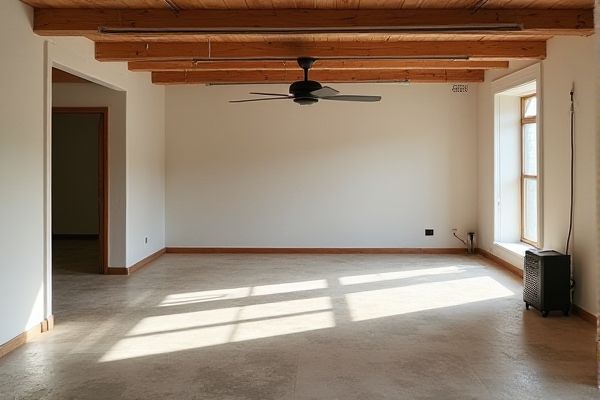
Choosing between a ceiling fan and an air circulator for your basement depends on the space size and airflow needs, where ceiling fans are ideal for broad, consistent air movement while air circulators provide targeted, stronger breezes. Explore the rest of the article to discover which option best fits your basement's ventilation requirements and keeps your space comfortable.
Table of Comparison
| Feature | Ceiling Fan | Air Circulator for Basement |
|---|---|---|
| Primary Function | Circulates air from above, cooling occupants | Moves air aggressively, improves basement airflow |
| Installation | Mounted on ceiling, requires wiring | Portable or wall-mounted, easy setup |
| Coverage Area | Large area under the fan | Targeted air circulation in specific basement spots |
| Energy Efficiency | Moderate energy usage | High efficiency, often lower power consumption |
| Airflow Pattern | Horizontal, gentle breeze | Powerful, directional airflow |
| Best Use Case | Cooling people in living areas | Preventing dampness, improving air quality in basements |
| Noise Level | Quiet to moderate | Usually louder due to higher airflow power |
Introduction: Comparing Ceiling Fans and Air Circulators for Basements
Ceiling fans provide consistent airflow by circulating air throughout the entire basement, helping reduce humidity and maintain a comfortable temperature. Air circulators offer targeted, high-velocity air movement, making them ideal for spot cooling or ventilating specific areas within the basement. Choosing between a ceiling fan and an air circulator depends on the basement size, ventilation needs, and desired airflow intensity.
How Ceiling Fans Work in Basement Spaces
Ceiling fans in basement spaces operate by rotating blades that create a downward airflow, which helps distribute warm or cool air evenly throughout the room, reducing temperature stratification. Their installation near the ceiling promotes efficient air movement, preventing stagnant air and maintaining consistent comfort levels. This airflow enhances ventilation, making ceiling fans an energy-efficient solution for basement climate control compared to traditional air circulators.
The Function and Design of Air Circulators
Air circulators are designed with powerful motors and aerodynamic blades to maximize air movement, making them highly efficient for ventilating basements where stagnant air often accumulates. Unlike ceiling fans that primarily provide overhead airflow, air circulators direct air horizontally at various angles, enhancing overall circulation and reducing humidity in confined spaces. Your basement benefits from the strategic placement of air circulators, which boost air exchange and promote a fresher, more comfortable environment.
Energy Efficiency: Ceiling Fan vs Air Circulator
Ceiling fans typically consume less energy than air circulators while effectively promoting airflow in basements, making them a cost-efficient cooling option. Air circulators, although powerful in rapidly moving air, often draw more electricity due to higher motor wattage and speed settings. Choosing an energy-efficient ceiling fan with an optimized blade design can significantly reduce electricity bills and enhance comfort in basement environments.
Installation Requirements and Flexibility
Ceiling fans require secure mounting to ceiling joists and sufficient clearance, often needing professional installation due to electrical wiring and ceiling height considerations in basements. Air circulators offer more flexible placement options, including floor, wall, or shelf mounting, with minimal installation effort and portability for optimal airflow direction. This makes air circulators a convenient choice for basements with low ceilings or limited electrical access compared to ceiling fans.
Airflow and Cooling Performance in Basements
Ceiling fans provide consistent, overhead airflow that effectively circulates cool air throughout basement spaces, enhancing overall comfort by reducing stagnant, humid air. Air circulators deliver a more focused, directional airflow, which can target specific areas but may lack the broad air distribution that ceiling fans offer in larger, open basements. Optimal cooling performance often depends on basement size and layout, with ceiling fans favored for widespread circulation and air circulators ideal for spot cooling and improving local ventilation.
Noise Levels: What to Expect
Ceiling fans in basements typically produce moderate noise due to motor and blade movement, which can vary based on the model and speed settings. Air circulators are designed to generate a focused airflow with quieter operation, often preferred for noise-sensitive environments. Expect ceiling fans to create a constant hum, while air circulators deliver powerful air movement with minimal background noise.
Cost Analysis: Purchase and Maintenance
Ceiling fans for basements generally have a higher upfront cost, ranging from $100 to $300, but require minimal maintenance, mostly involving periodic cleaning and occasional lubrication. Air circulators tend to be less expensive initially, typically priced between $50 and $150, but may demand more frequent filter replacements and motor servicing, increasing long-term expenses. Your choice should weigh not only the immediate purchase price but also ongoing maintenance to ensure cost-effectiveness over time.
Safety Considerations for Basement Use
Ceiling fans in basements require secure mounting and moisture-resistant materials to prevent electrical hazards and structural damage. Air circulators, designed with sealed motors and often featuring tip-over switches, offer enhanced safety for damp or uneven basement floors. Both devices should comply with local building codes and be used with appropriate humidity controls to minimize mold and corrosion risks.
Which is Best for Your Basement: Final Verdict
A ceiling fan provides consistent airflow and helps reduce humidity in basements, making it ideal for long-term comfort and ventilation. An air circulator excels at distributing air quickly and efficiently, especially in larger or irregularly shaped basements. For optimal basement climate control, ceiling fans are best for sustained airflow and energy efficiency, while air circulators work well for targeted, rapid air movement.
 homyna.com
homyna.com